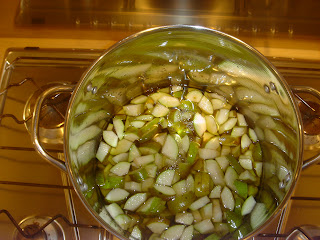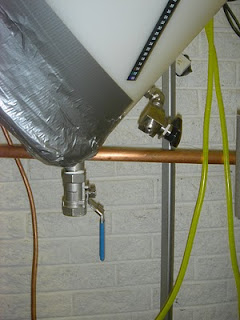Yeserday there was an estate produce sale, the funds for the sale will go towards the further development of a part of the estate grounds (rhododendrons being added). I had planned a cider this year and yesterdays visit to the gardens jump started the process. We bought six kilos of apples and just over a kilo of pears. The apple and pear trees are grown as Espalier trees(trained and grown symetrically against the walls of the garden). It won't add one iota of flavour to the final cider but it looks good!
I had two vanilla pods remaining from Turkey, these were bought with this cider in mind. The recipe is as follows
3kgs apples (type unknown, sharp enough for the job though)
1.2 kgs Pears
2 vanilla pods
22 ltrs apple juice
1 cup of steeped Tea
1 packet cider yeast
This is a very simple process in comparison to the making of beer, more akin to baking than brewing. We cored and removed any poor bits on the pears.
Once we had finished the preparation the pears went into a stainless steel pan along with a litre of apple juice.
While the pears were coming to the boil and softening we continued with preparing the apples.
3kgs is a lot of apples but since i have no fruit press (yet) the only way i can use solid apples/pears it to reduce to pulp with heat and let the yeast break them down completely in the fermentation cycle.
I tried a single vanilla pod in a cider i made last year. The flavour/aroma of the vanilla pod was present in the final cider but it could have been stronger. This year i've used two pods and i am keeping the pods in the fermenter while the yeast works to maximise their impact.
The pods are broken up, put in a nylon net bag and placed in the pot. This helps in two ways.
No1, the vannila essence is released from the pods during the boil. No2 The nylon bag and pods are sterilised through the boiling process. This is critical as they will be placed in the fermentation vessel and as such cannot carry any unwanted bacteria which could result in a ruined batch of cider.
At this point i sterilised the fermentation vessel, funnel, cork and airlock. The golden rule of brewing is that ANYTHING that will come into contact with the product post boil MUST be sterile. Most brewers go a bit over the top in this department. One infected brew is too many so i use loads of thin bleach and/or heat post boil.
Different brewers go different ways in their brews. My preference is to use a real cider yeast. I find i end up with a good quality cider if i do. In the picture below is the FV, cider yeast, vanilla pods in the FV and the tea for the tannin addition.
We then filled the FV through a funnel with the pureed pears and apples, poured in some apple juice if the funnel blocked with skins.
It went well and before i knew it we were ready for a Dr Frankensteins lab equipment photo!
The yeast is then pitched and the FV's transfered to another room.
Sometimes the simplest ideas are the best. A couple of years ago i was thinking about which herb/spice etc would go well in a cider. In this case the inspiration was the flavour of apple pie and vanilla ice cream, the pears were to hopefully give a third flavour layer to the cider.
Edit- 4 hours later.
Went for a walk at Haddo house this afternoon (i did say i like The Green) and came back to an oveflowing FV airlock and apple bits down the side of the FV! I had forgotten how fast and vigourously cider yeast takes off. No big deal, had a clean up and i will check progress every couple of hours.
If anybody decides to make the cider its worth remembering that the pureed fruit will all sink to the bottom of the FV once fermentation is complete. The room the FV is in smells fantastically of apple zing!
Boring cost bit
Apple juice 22 ltrs £13.00
Apples 3kgs £1.20
Pears 1.2kgs £1.60
Cider yeast £1.00
Heat £1.00
=£17.80 / 44 = 40p per pint.
I'm not sure what the price would be for a good strong cider but i think that anyone reading this with access to a fruiting apple tree should try and beat my price per pint and let me know how they get on. The expense in cider made my way is in the cartoned apple juice. If you go the apple juice route make sure it's 100% juice. If you go straight to the tree with an apple press i await a link to your blog and look forward to reading it!
We had a great time today making this and it turned out to be a family participation thing as it was done in the kitchen and not the cold garage. The only unknown in the process is the final alcohol content of the cider. In the past the cider i have made finished at 1.000 gravity. In other words there were no residual sugars left in the cider, the yeast consumed it all. This leads to a dry cider which is not dissimilar to some white wines i have tried. My preference is for dry cider but if its not for you i would advise a net search on sweet cider yeasts that finish at a higher gravity.
I measured the gravity of the apple juice while cold and it measured at 1.045. I did not take a gravity reading once the fruit had been added as there was no easy way to do so and i did not want to risk an infection. Instead i went to the net for some (rough) calcs.
3kg apple = +300 grmms sugar
1.2kg pear = +100 grmms sugar
= 8 gravity points @ 40 pints
Apple juice + fruit =1.053 gravity points = 6.9% ABV @ 1.000 Final Gravity.








































